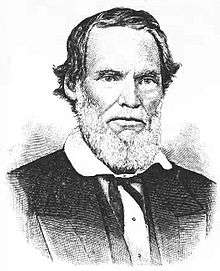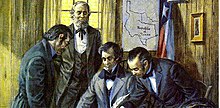Robert Emmett Bledsoe Baylor
Robert Emmett Bledsoe Baylor (May 10, 1793 – January 6, 1874) was an ordained Baptist minister, slaveowner, district judge, politician and co-founder of Baylor University.[1]
Robert Emmett Bledsoe Baylor | |
|---|---|
 | |
| Member of the U.S. House of Representatives from Alabama's 2nd district | |
| In office March 4, 1829 – March 3, 1831 | |
| Preceded by | John McKee |
| Succeeded by | Samuel W. Mardis |
| Member of the Alabama House of Representatives | |
| In office 1824 | |
| Personal details | |
| Born | Robert Emmett Bledsoe Baylor May 10, 1793 Lincoln County, Kentucky |
| Died | January 6, 1874 (aged 80) Gay Hill, Texas |
| Political party | Jacksonian |
Early life
Baylor was born on May 10, 1793, in Lincoln County, Kentucky, to Walker and Jane Bledsoe Baylor.[2] Baylor attended schools around Paris, Kentucky.[3] He served in the Kentucky militia during the War of 1812. After the war, he studied law under his uncle Jesse Bledsoe and practiced law in Kentucky. He was briefly a member of the Kentucky House of Representatives from 1819 to 1820, before he resigned and moved to Alabama.[1][4]
In Alabama, he practiced law and continued his political career. In 1824, he was elected to the Alabama House of Representatives. Baylor was elected as a Jacksonian to the Twenty-first Congress (March 4, 1829 – March 3, 1831) from Alabama's 2nd congressional district and was an unsuccessful candidate for election in 1830 to the Twenty-second Congress. In 1836, Baylor fought as a lieutenant colonel against the Creek tribe in the Creek War of 1836.[4] In 1839, he converted to Christianity and was ordained a Baptist minister.[1]
Texas career
In 1839, Baylor moved to La Grange, Texas.[3] He quickly made a name for himself in Texas law as judge of the Third Judicial District of the Congress of the Republic of Texas, and was appointed to the Supreme Court of the Republic of Texas as an associate justice in 1841, a position he would hold until the annexation of Texas in 1845.[4] After Texas attained statehood, Baylor was appointed by Governor J. P. Henderson as judge over the Third Judicial District of the new state, a position he would hold until his retirement in 1863.[4] He lived the remainder of his life in Gay Hill, Texas.[3]
Baylor was one of the first officers of the Texas Baptist Educational Society[5] and, in 1844, along with Reverend William Tryon and Reverend James Huckins, sent a petition to the Congress of the Republic of Texas asking the nation to charter a Baptist university.[6] In response to this petition, The Republic of Texas produced an Act of Congress that was signed on February 1, 1845, by Anson Jones, providing the charter that yielded Baylor University and, later, the University of Mary Hardin-Baylor.

In the 1850's, Baylor was an influential leader in the Xenophobic and White Nativist Texas Know Nothing Party and was named the Texas Know Nothing Party's "Grand President."[7] During the Civil War, Baylor supported the Confederacy and the grounds of Baylor University, then in Independence, were used as a training and staging ground for the Confederate Army.[8] Baylor's nephew, John R. Baylor, was a prominent leader in the Confederacy serving as both a governor and later as a member of the Confederate Congress.
Consistent with the law of Texas at the time, in his role as a judge he once punished an abolitionist harboring an escaped slave. Another man was punished for not returning a borrowed slave promptly. In 1854, Judge Baylor sentenced a slave to hang for arson. In 1856, he ordered the execution of yet another slave. In 1857, he levied a heavy fine on a white person who bought some bacon from a slave. And in 1862, as the Civil War raged, he ordered the execution of a slave for “intent to rape a white female.”[9]
Personal life
Baylor was a Mason from 1825 until his death.[4] He never married and had no children, although he was close to his nephew John Baylor.[2]
Like many of his time, Baylor believed slavery was a God-ordained reality. He initially owned two slaves to work his small farm and, according to tax records, by 1860 he owned at least 20 slaves valued at more than $18,000.[10]
He died on January 6, 1874, and was buried in Independence, Texas, on the original site of Baylor University. In 1917, his remains were exhumed and transferred to the University of Mary Hardin-Baylor in Belton, Texas.
References
- Robert Emmett Bledsoe Baylor Papers, Accession #1362, The Texas Collection, Baylor University
- "The Naming of Baylor". About Baylor. Baylor University. Retrieved February 10, 2015.
- Deeringer, Martha (May 2019). "Baylor, the Man". Texas Co-op Power: 29.
- "BAYLOR< ROBERT EMMETT BLEDSOE". The Handbook of Texas. Texas State Historical Association.
- "TEXAS BAPTIST EDUCATIONAL SOCIETY". The Handbook of Texas. Texas State Historical Association. Missing or empty
|url=(help) - "History". About Baylor. Baylor University. Retrieved February 6, 2015.
- Wooster, Ralph A. (1976). "An Analysis of the Texas Know Nothings". The Southwestern Historical Quarterly. 70 (3): 414–423.
- Van Gorter, Christian. "Baylor's history mirrors our nation's in matters of race". Waco Tribune Herald.
- van Gorder, A. Christian. "Baylor's history mirrors our nation's in matters of race". WacoTrib.com. Retrieved July 4, 2020.
- van Gorder, A. Christian. "Baylor's history mirrors our nation's in matters of race". WacoTrib.com. Retrieved July 4, 2020.
External links
- Robert Emmett Bledsoe Baylor at Find a Grave
- Robert E.B. Baylor at Biographical Directory of The United States Congress
| U.S. House of Representatives | ||
|---|---|---|
| Preceded by John McKee |
Member of the U.S. House of Representatives from Alabama's 2nd congressional district March 4, 1829 – March 3, 1831 |
Succeeded by Samuel Wright Mardis |